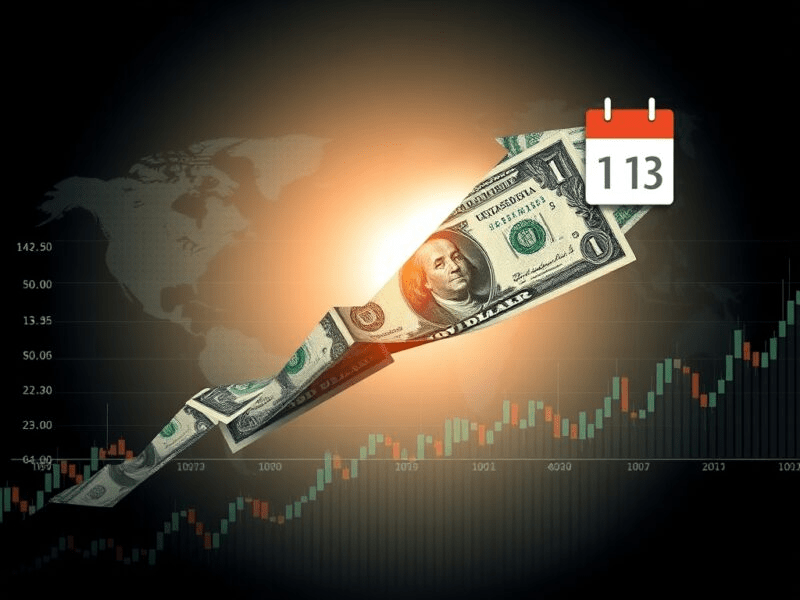based on materials from the website - By ItsBitcoinWorld

The financial world is buzzing as the US dollar marks a remarkable milestone, preparing for its best weekly performance in three years. This significant rise is not just news for currency traders; it resonates across the entire financial landscape, including the volatile realm of cryptocurrencies. For those investing in digital assets, understanding the underlying forces driving this dollar dominance is paramount, as macroeconomic changes often dictate the tides of capital into riskier assets such as Bitcoin and altcoins. What exactly is driving this impressive rise, and how will the long-awaited non-farm payroll report affect its future trajectory and the global economy as a whole?
The recent rise of the US dollar has been truly impressive, captivating both analysts and investors. Its ascent to dominance among major currencies this week is the culmination of a series of powerful economic and geopolitical factors. This is not about a single event, but a confluence of circumstances that have made the dollar the preferred asset worldwide.
What exactly do the non-farm payroll (NFP) data represent? The NFP report provides a comprehensive picture of the state of the US labor market, specifically measuring the number of new jobs created in non-farm sectors over the previous month. It also includes important data such as the unemployment rate and average hourly earnings, which are key indicators of wage inflation.
While the non-farm payroll (NFP) data immediately attract attention, the sustained strength of the dollar is also deeply rooted in a broader spectrum of economic data. These indicators collectively provide a complete picture of the US economy's state in relation to the rest of the global economy, influencing investor sentiment and capital flows.
Inflation Data (CPI, PPI): The Consumer Price Index (CPI) and Producer Price Index (PPI) measure inflation at the consumer and producer levels, respectively. Persistently high inflation figures in the US, especially compared to lower inflation in other major economies, underscore the need for the Federal Reserve to maintain a tight policy, supporting the dollar.
Retail Sales: This report tracks consumer spending, a significant portion of GDP in consumption-oriented economies like the US. High retail sales indicate strong consumer confidence and economic dynamism, contributing to positive economic outlooks and strengthening the dollar.
Business Activity Indices (PMI) in Manufacturing and Services: Business Activity Indices (PMI) for both manufacturing and services are leading indicators of economic activity. High PMI values indicate an expansion in business activity, job creation, and future economic growth, providing additional support to the US dollar.
Understanding this complex network of economic indicators is crucial for anyone tracking the dollar's exchange rate, as it is not about a single report, but about the cumulative weight of all data that shapes the Fed's forecasts and, consequently, the dollar's value.
For cryptocurrency investors, the rise of the dollar is an especially important trend to track. While crypto markets often operate on their own unique scenarios, they are not immune to macroeconomic factors. A strong dollar typically correlates with a reluctance to take risks in global markets.
When global economic uncertainty rises and the dollar acts as a safe haven, investors tend to reduce their exposure to risky assets. Cryptocurrencies, despite their innovative nature, are still largely perceived as high-risk, high-reward investments. This means that capital may flow from cryptocurrencies into more traditional and safer assets, such as the dollar and US Treasury bonds.
Liquidity Drain: A strong dollar can absorb liquidity from other markets. If investors sell assets denominated in other currencies to buy dollars, or simply hold cash in dollars, this can reduce the available capital for investment in more speculative markets, including cryptocurrencies.
Dynamics of Stablecoins: While stablecoins like USDT or USDC are pegged to the US dollar, their collateral and the regulatory framework surrounding them are still under close scrutiny. A strong dollar does not directly affect their peg but highlights the crypto ecosystem's dependence on the stability of fiat currencies.
Understanding these correlations is crucial. While Bitcoin is often marketed as "digital gold" and a hedge against inflation, its dynamics in recent periods of dollar strength indicate that it still behaves largely as a risky asset sensitive to broader macroeconomic changes.
The impressive rise of the US dollar, marking the best week in three years, underscores its key role in the global economy. Thanks to proactive interest rate policies, its continued appeal as a safe asset, and the relative resilience of the US economy, the strength of the dollar is a defining characteristic of the current financial markets.
#MarketRebound , #Сryptomarketnews
In this group, we strive to promptly inform readers about news articles (more than a dozen websites) related to changes in the cryptocurrency market and financial markets. There is no goal here to impose on any readers the correctness (or incorrectness) of the article on the site!
The information is retransmitted by us to familiarize with changes in the "news agenda", and without claims to originality! Conclusions after reading this information, every sensible person will always make independently!


